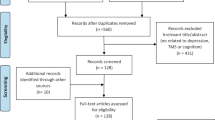Abstract
In order to search for possible EEG predictors of the effectiveness of combined antidepressive therapy, which includes a three-week course of high-frequency rhythmic transcranial magnetic stimulation (rTMS) of the dorsolateral prefrontal cortex (DLPFC) of the left hemisphere in 30 patients with drug-resistant depression the correlations between pre-treatment EEG spectral power values, and post-treatment quantitative outcome conditions of patients were analyzed. The “responders” (23 out of 30) exhibited significant negative correlations of the post-treatment HDRS-17 scale total score with the EEG spectral power values in θ2 (6–8 Hz) and α1 (8–9 Hz) frequency sub-bands in the parietal–occipital–posterior temporal leads. The “non-responders” (7 out of 30) exhibited similar correlations between the post-treatment HDRS-17 scale total score and θ2 (6–8 Hz) EEG sub-band spectral power in the frontal–central–temporal areas of the right hemisphere. Thus, possible EEG predictors of the effectiveness of combined antidepressive therapy, including rTMS of the left DLPFC, are the pre-treatment parameters of θ2 and α1 EEG frequency sub-bands.


Similar content being viewed by others
REFERENCES
Preventing Suicide: A Global Imperative, Geneva: W.H.O. Press, 2014.
Smulevich, A.B., Depressii pri somaticheskikh i psikhicheskikh zabolevaniyakh (Depressions in Somatic and Mental Disorders), Moscow: Mosk. Inf. Agentstvo, 2007.
Krasnov, V.N., Rasstroistva affektivnogo spektra (Affective Spectrum Disorders), Moscow: Prakticheskaya Meditsina, 2011.
Fava, M., Diagnosis and definition of treatment-resistant depression, Biol. Psychiatry, 2003, vol. 53, no. 8, p. 649.
Mosolov, S.N., Resistance to psychopharmacotherapy and methods to overcome it, Psikhiatr. Psikhofarmakoter., 2002, vol. 4, no. 4, p. 132.
Mazo, G.E. and Krizhanovskii, A.S., Specific neurobiological profile of therapeutically resistant depression: pro et contra, Sovrem. Ter. Psikh. Rasstroistv, 2012, no. 1, p. 2.
Padberg, F., Zwanzger, P., Thoma, H., et al., Repetitive transcranial magnetic stimulation (rTMS) in pharmacotherapy-refractory major depression: comparative study of fast, slow and sham rTMS, Psychiatry Res., 1999, vol. 88, no. 3, p. 163.
Gross, M., Nakamura, L., Pascual-Leone, A., and Fregni, F., Has repetitive transcranial magnetic stimulation (rTMS) treatment for depression improved? A systematic review and meta-analysis comparing the recent vs. the earlier rTMS studies, Acta Psychiatr. Scand., 2007, vol. 116, no. 3, p. 165.
Narushima, K., McCormick, L.M., Yamada, T., et al., Subgenual cingulate theta activity predicts treatment response of repetitive transcranial magnetic stimulation in participants with vascular depression, J. Neuropsychiatry Clin. Neurosci., 2010, vol. 22, no. 1, p. 75.
Micoulaud-Franchi, J.A., Richieri, R., Cermolac-ce, M., et al., Parieto-temporal alpha EEG band power at baseline as a predictor of antidepressive treatment response with repetitive transcranial magnetic stimulation: a preliminary study, J. Affective Disord., 2012, vol. 137, nos. 1–3, p. 156.
Maslennikov, N.V., Tsukarzi, E.E., and Mosolov, S.N., Depression in schizophrenia: assessment of dynamics of cognitive functions in the treatment of transcranial magnetic stimulation, Sots. Klin. Psikhiatriya, 2013, vol. 23, no. 1, p. 5.
Noda, Y., Nakamura, M., Saeki, T., et al., Potentiation of quantitative electroencephalograms following prefrontal repetitive transcranial magnetic stimulation in patients with major depression, Neurosci. Res., 2013, vol. 77, nos. 1–2, p. 70.
Iznak, A.F., Iznak, E.V., Damyanovich, E.V., Oleichik, I.V., Bologov, P.V., Kazachinskaya, I.I., and Medvedeva, T.I., Transcranial magnetic stimulation in combined treatment of pharmacoresistant depression: dynamics of clinical, psychological, and EEG parameters, Hum. Physiol., 2015, vol. 41, no. 5, p. 503.
Mel’nikova, T.S., Tsukarzi, E.E., Kovalev, A.V., and Mosolov, S.N., The spectral characteristics of the electroencephalogram (EEG) is the potential biomarkers of efficacy of Transcranial Magnetic Stimulation (TMS) in resistant depression, Sots. Klin. Psikhiatr., 2016, no. 3, p. 2.
Iznak, A., Iznak, E., Damyanovich, E., Medvedeva, T., and Oleichik, I., Comparative efficiency of rTMS in combined treatment of pharmaco-resistant depression, L’Encéphale, 2019, vol. 45, suppl. 2, p. S65.
Damyanovich, E.V., Iznak, E.V., Oleichik, I.V., et al., Changes in the spatial organization of brain activity after combined antidepressive therapy including transcranial magnetic stimulation, Hum. Physiol., 2019, vol. 45, no. 1, p. 23.
Kar, S.K., Predictors of response to repetitive transcranial magnetic stimulation in depression: a review of recent updates, Clin. Psychopharmacol. Neurosci., 2019, vol. 17, no. 1, p. 25.
Iznak, A.F., Tiganov, A.S., Iznak, E.V., and Sorokin, S.A., EEG correlates and possible predictors of the efficacy of the treatment of endogenous depression, Hum. Physiol., 2013, vol. 39, no. 4, p. 378.
Iznak, A.F., Iznak, E.V., Oleichik, I.V., et al., EEG correlates of frontal dysfunction as predictors of relative pharmacoresistance in the treatment of endogenous affective disorders, Zh. Nevropatol. Psikhiatr. im. S.S. Korsakova, 2014, vol. 114, no. 12, p. 53.
Iznak, A.F., Iznak, E.V., Abramova, L.I., and Lozhnikov, M.A., Models for the quantitative prediction of therapeutic responses based on the baseline EEG parameters in depressive patients, Hum. Physiol., 2019, vol. 45, no. 6, p. 614.
Mitrofanov, A.A., Komp’yuternaya sistema ananliza i topograficheskogo kartirovaniya elektricheskoi aktivnosti mozga s neirometricheskim bankom EEG-dannykh (opisanie i primenenie) (Computer System of Analysis and Topographic Mapping of Brain Electric Activity with Neurometric EEG Database: Description and Application), Moscow, 2005.
Iznak, A.F., Zhigulskaya, S.E., Roshchina, I.F., et al., EEG correlates of “mild” disorders of higher cortical functions, Hum. Physiol., 2001, vol. 27, no. 1, p. 1.
Funding
The study was supported by the Russian Foundation for Basic Research, project no. 18-01-00029a.
Author information
Authors and Affiliations
Corresponding author
Ethics declarations
COMPLIANCE WITH ETHICAL STANDARDS
All studies were conducted in accordance with the principles of biomedical ethics formulated in the 1964 Declaration of Helsinki and its subsequent updates, and approved by the local bioethical committee of the Mental Health Research Centre (Moscow, Russia).
CONFLICT OF INTEREST
The authors declare no obvious and potential conflicts of interest related to the publication of this article.
INFORMED CONSENT
Each study participant provided a voluntary written informed consent, signed by him after explaining the potential risks and benefits, as well as the nature of the upcoming study.
Rights and permissions
About this article
Cite this article
Iznak, E.V., Iznak, A.F. & Oleichik, I.V. Quantitative EEG in Prediction of Efficiency of Combined Antidepressive Treatment Using Transcranial Magnetic Stimulation. Hum Physiol 46, 621–626 (2020). https://doi.org/10.1134/S0362119720060043
Received:
Revised:
Accepted:
Published:
Issue Date:
DOI: https://doi.org/10.1134/S0362119720060043




